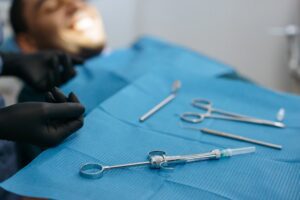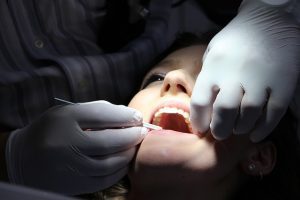Obstructive sleep apnea can be a frustrating and disruptive health problem. Sleep can be so important both to our functioning and enjoyment of life. Most people assume sleep apnea only causes snoring and disruption for your sleeping partner, but it actually results in low blood oxygen levels and serious sleep disruption for the afflicted as well.
The condition is caused by the tongue being sucked into the back of the throat as the muscles in the throat relax. This blocks the upper airway, disrupting air flow and oxygen levels to the brain. When oxygen gets low enough, the sleeper usually awakens partially, clearing the throat and allowing air to flow again. This constant waking up process prevents you from getting a fully deep and relaxing sleep — and it can seriously affect your functioning while you are awake.
In addition to sleeplessness, sleep apnea can cause high blood pressure, metabolic issues, and other chronic health problems. If nonsurgical approaches don’t help, oral surgery may be necessary. Fortunately oral surgery treatment is effective, long-lasting, and can greatly improve your quality of life and day time energy.
There are a variety of oral surgical approaches to treat sleep apnea, depending on the severity of the condition and other health factors.
Nasal Surgery
Daytime nasal obstruction and nocturnal nasal congestion can lead to sleep disordered breathing. There are 3 anatomical areas of the nose that can contribute to the problem:
- the septum
- the turbinates
- the nasal valve.
Septoplasty and turbinate reduction is a common nasal surgery approach that straightens out the septum and reduces the size of the turbinates. It effectively creates more room in the nose so air can pass freely and effortlessly.
Some patients suffer from nasal valve collapse — caused by weakness in the lower nasal cartilages that hold open the nostrils. To treat this problem, the deviated cartilage is removed from the septum and strategically relocated to strengthen the valve and prevent collapse.
Soft Palate Implants
Otherwise, known as the Pillar Procedure, this minimally invasive procedure can cure snoring and mild cases of sleep apnea. Three polyester rods are surgically placed into the soft palate. This creates an inflammatory response of the surrounding soft tissues that stiffens the tissues in the soft palate — making it less likely to contact the back wall of the pharynx as you relax during deep stages of sleep.
Uvulopalatopharyngoplasty
This is one of the most common oral surgical treatments for sleep apnea — though not always the most effective. Extra tissue from the top of your throat and the back of your mouth is removed to allow more air flow. If present, the tonsils are also removed. Sutures are put into place to keep the area wide open and prevent collapse. For this procedure, you’ll need to stay overnight in the hospital. Expect a painful recovery that can last up to a week.
Maxillomandibular advancement
Some sleep apnea patients have tiny jaws that can make breathing difficult at night.
This procedure is sometimes referred to as jaw repositioning. It’s an oral surgery approach that moves your jaw forward, typically 10 to 12 mm — allowing more space behind the tongue to open the airway. The jaw bones are stabilized with titanium plates. Jaw repositioning can be a more difficult and invasive procedure because the bone needs to be precisely cut and the teeth repositioned to a high degree of accuracy. Some patients will need to have their jaws wired shut for a time as the jaw heals. It’s a painful procedure that requires several nights stay in a hospital. Fortunately long term success rates are high at about 90 percent.
Anterior inferior mandibular osteotomy
This is an oral surgery procedure that divides your chin bone into two parts so that your tongue can move forward. This opens air flow while stabilizing your tongue and your mouth. Recovery times are short. Unfortunately, the treatment is not always effective. Often this treatment will be used along with other oral surgery approaches to increase its effectiveness.
Tongue Advancement
This is a procedure that advances one of the main tongue muscles, the genioglossus muscle, forward to prevent the tongue from falling backward during sleep. This is done by making a rectangular cut in the jaw bone where the genioglossus muscle attaches and moving the bone forward with the muscle still attached. The bone is then fixed into place with a small titanium plate to prevent the tongue retracting back into the floor of the mouth.
Tongue Base Reduction
Sometimes tissue is removed from the tongue in order to allow more air flow. One approach involves using radiofrequency waves to shrink tongue tissues without damaging other areas of the mouth. It’s a minimally invasive procedure that can be done while you are awake for the treatment. Several treatments are usually necessary.
The tongue can also be reduced by a direct incision — a process known as midline glossectomy. The treatment is done under general anesthesia. There is a slight but very real chance of airway compromise, so you will be required to stay overnight in the hospital. This has been shown to be a highly effective treatment.










